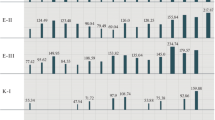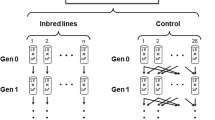Abstract
The empirical distributions of the average viability and fitness of mutation accumulation lines of Drosophila melanogaster were analyzed using minimum distance estimation. Data come from two different experimental designs where mutations were allowed to accumulate: 1) in copies of chromosome II protected from natural selection and recombination (viability: Mukai et al., 1972; Ohnishi, 1977; fitness: Houle et al., 1992), 2) in inbred lines derived from the same isogenic stock (viability: Fernández & López-Fanjul, 1996; fitness: this paper). Information from all data sets converged, indicating that the mutational rates were small, about 1% for viability and 3% for fitness. For both traits, the rate of mutational decline appears to be smaller than suggested by previous studies (about one-fifth of the latter), the average mutational effect was neither severe nor very slight, ranging from −0.1 to −0.3, and the distribution of mutant effects was, at most, slightly leptokurtic. Therefore, the mutational load in natural populations is one to two orders of magnitude smaller than previously thought (as based upon analyses conditional to estimates of the mutational decline of viability or fitness that appear to be biased upward). Over 95% of the mutational variance of each trait was contributed by non-slightly deleterious mutations (absolute homozygous effect larger than 0.03 or 0.1, depending on the data set considered) occurring at a rate not higher than 0.025 per haploid genome and generation. Our data suggest that most deleterious mutations affecting fitness act mainly through a single component-trait.
Similar content being viewed by others
References
Bateman, A.J., 1959. The viability of near-normal irradiated chromosomes. Intern. J. Radiation Biol. 1: 170-180.
Caballero, A., M.A. Toro & C. López-Fanjul, 1991. the response to artificial selection from new mutations in Drosophila melanogaster. Genetics 128: 89-102.
Chovnick, A., 1973. Gene conversion and transfer of genetic information within the inverted region of inversion heterozygotes. Genetics 75: 123-131.
Crow, J.F., 1992. The high genomic mutation rate. Evolutionary Genetics 2: 605-607.
Crow, J.F.&M. Kimura, 1970. An Introduction to Population Genetics Theory. New York: Harper & Row.
Crow, J.F. & M.J. Simmons, 1983. The mutation load in Drosophila, pp. 1-35 in The Genetics and Biology of Drosophila, vol. 3C, edited by M. Ashburner, H.L. Carson & J.N. Thompson Jr. London: Academic Press.
Fernández, J. & C. López-Fanjul, 1996. Spontaneous mutational variances and covariances for fitness-related traits in Drosophila melanogaster. Genetics 143: 829-837.
Fernández, J. & C. López-Fanjul, 1997. Spontaneous mutational genotype-environment interaction for fitness-related traits in Drosophila melanogaster. Evolution 51: 856-864.
Fry, J.D., S.L. Heinsohn & T.F.C. Mackay, 1996. The contribution of new mutations to genotype-environment interaction for fitness in Drosophila melanogaster. Evolution 50: 2316-2327.
García-Dorado, A., 1997. The rate and effects distribution of viability mutation in Drosophila: minimum distance estimation. Evolution 51: 1130-1139.
García-Dorado, A. & J.A. González, 1996. Stabilizing selection detected for bristle number in Drosophila melanogaster. Evolution 50: 1573-1578.
Houle, D., D.K. Hoffmaster, S. Assimacopoulos & B. Charlesworth, 1992. The genomicmutation rate for fitness in Drosophila. Nature 359: 58-60.
Houle, D., B. Morikawa & M. Lynch, 1996. Comparing mutational variabilities. Genetics 143: 1467-1483.
Keightley, P.D., 1994. The distribution of mutation effects on viability in Drosophila melanogaster. Genetics 138: 1315-1322.
Keightley, P.D., 1996. Nature of deleterious mutation load in Drosophila. Genetics 144: 1993-1999.
Keightley, P.D. & W.G. Hill, 1990. Variation maintained in quantitative traits with mutation-selection balance: pleiotropic side effects on fitness traits. Proc. R. Soc. Lond. B Biol. Sci. 253: 291-296.
Kimura, M., 1969. The number of heterozygous nucleotide sites maintained in a finite population due to steady flux of mutations. Genetics 61: 893-903.
Kondrashov, A.S., 1995. Contamination of the genome by very slightly deleterious mutations: why have we not died 100 times over? J. Theor. Biol. 175: 583-594.
Kondrashov, A.S. & D. Houle, 1994. Genotype-environment interactions and the estimation of the genomic mutation rate in Drosophila melanogaster. Proc. R. Soc. Lond. B Biol. Sci. 258: 221-227.
Lande, R., 1995. Mutation and conservation. Conservation Biology 4: 782-791.
Lynch, M., J. Conery & R. Bürger, 1995. Mutation accumulation and the extinction of small populations. Am. Nat. 146: 489-518.
Mukai, T., 1964. The genetic structure of natural populations of Drosophila melanogaster. I. Spontaneous mutation rate of polygenes controlling viability. Genetics 50: 1-19.
Mukai, T., S.I. Chigusa, L.E. Mettler & J.F. Crow, 1972. Mutation rate and dominance of genes affecting viability in Drosophila melanogaster. Genetics 72: 333-355.
Ohnishi, O., 1977. Spontaneous and ethyl methanesulfonate-induced mutations controlling viability in Drosophila melanogaster. II. Homozygous effects of polygenic mutations. Genetics 87: 529-545.
Parr, W.C. & W.R. Schucany, 1988. Minimum distance and robust estimation. J. Amer. Stat. Assoc. 75: 616-624.
Santiago, E., J. Albornoz, A. Domínguez, M.A. Toro & C. López-Fanjul, 1992. The distribution of effects of spontaneous mutations on quantitative traits and fitness in Drosophila melanogaster. Genetics 140: 219-229.
Wolfowitz, J., 1957. The minimum distance method. Ann. Math. Statist. 28: 75-88.
Woodward, W.A., W.C. Parr, W.R. Schucany & H. Lindsley, 1984. A comparison of minimum distance and maximum likelihood estimation of a mixture proportion. J. Amer. Stat. Assoc. 79: 590-598.
Wray, N.R., 1990. Accounting for mutation effects in the additive genetic varianceco-variance matrix and its inverse. Biometrics 46: 177-186.
Author information
Authors and Affiliations
Corresponding author
Rights and permissions
About this article
Cite this article
García-Dorado, A., Monedero, J.L. & López-Fanjul, C. The mutation rate and the distribution of mutational effects of viability and fitness in Drosophila melanogaster. Genetica 102, 255–265 (1998). https://doi.org/10.1023/A:1017086909282
Issue Date:
DOI: https://doi.org/10.1023/A:1017086909282




